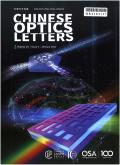High energy efficiency soliton microcomb generation in high coupling strength, large mode volume, and ultra-high-Q micro-cavity
IF 2.8
2区 物理与天体物理
Q2 OPTICS
引用次数: 0
Abstract
The nonlinear physics dynamics of temporal dissipative solitons in a microcavity hinder them from attaining high power from pump lasers with a typical nonlinear energy conversion efficiency of less than 1%. Here, we experimentally demonstrate a straightforward method for improving the output power of soliton combs using a silica microrod cavity with high coupling strength, large mode volume, and high-Q factor, resulting in a low-repetition-rate dissipative soliton ( ∼ 21 GHz) with an energy conversion efficiency exceeding 20%. Furthermore, by generating an ∼ 105 GHz 5 × FSR (free spectral range) soliton crystal comb in the microcavity, the energy conversion efficiency can be further increased up to 56%.在高耦合强度、大模体积和超高q微腔中产生高能效孤子微梳
微腔中时间耗散孤子的非线性物理动力学阻碍了它们从典型的非线性能量转换效率小于1%的泵浦激光器中获得高功率。在这里,我们通过实验证明了一种使用高耦合强度、大模体积和高q因子的硅微棒腔来提高孤子梳输出功率的直接方法,从而产生低重复率的耗散孤子(~ 21 GHz),能量转换效率超过20%。此外,通过在微腔中产生一个~ 105 GHz5×FSR(自由光谱范围)的孤子晶体梳,能量转换效率可进一步提高到56%。
本文章由计算机程序翻译,如有差异,请以英文原文为准。
求助全文
约1分钟内获得全文
求助全文
来源期刊

Chinese Optics Letters
物理-光学
CiteScore
5.60
自引率
20.00%
发文量
180
审稿时长
2.3 months
期刊介绍:
Chinese Optics Letters (COL) is an international journal aimed at the rapid dissemination of latest, important discoveries and inventions in all branches of optical science and technology. It is considered to be one of the most important journals in optics in China. It is collected by The Optical Society (OSA) Publishing Digital Library and also indexed by Science Citation Index (SCI), Engineering Index (EI), etc.
COL is distinguished by its short review period (~30 days) and publication period (~100 days).
With its debut in January 2003, COL is published monthly by Chinese Laser Press, and distributed by OSA outside of Chinese Mainland.
 求助内容:
求助内容: 应助结果提醒方式:
应助结果提醒方式:


